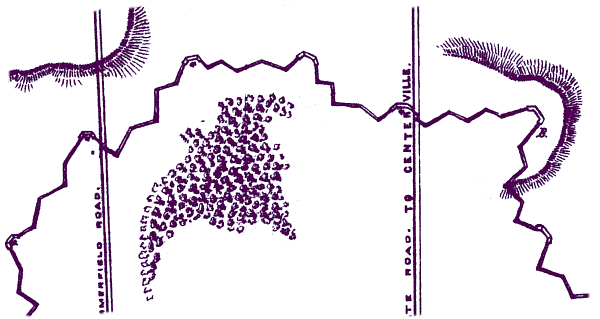|
 |
Detail Showing A Section Of Continuous Tenaille Line. Fortifications
Of Selma, Alabama. 1865. |
 |
Tenaille lines were, according to some engineering manuals, developed
to correct the defects inherent in the redan and curtain trace, that is,
give better covering fire across the salients of the line's redans and eliminate
dead spaces immediately in front of the line. |
|
|
|
|
 |
|
|
Draw a right line of any length and mark the points of division
along the line that locate the positions of the line's redan capitals. In
this case the capitals will be 100 yards apart.
|
|
|
|
|
|
 |
|
|
Bisect each 100 yard distance between capitals and mark the points
of bisection. These points will be used to locate the re-entering angles
where the faces of collateral redans intersect on a second interior boundary
line. They will also divide the front boundary into line segments that are
50 yards long. |
|
|
|
|
|
 |
|
|
Drop perpendicular lines from each point of division on the front
boundary line that are equal in length to the length of each front boundary
line segment, that is, in this case, 50 yards. Connect the interior extremities
of the perpendicular lines by drawing a right line from one end of the tenaille
line to the other. This creates a series of square boxes: all the angles
are equal and all sides are equal. |
|
|
|
|
|
 |
|
|
To finish the equal angle tenaille line begin at one or other
end of the front boundary line and draw a diagonal line across each box,
from the front boundary line to the interior extremity of the next perpendicular
line. This creates the typical tenaille line lateral zig-zag pattern of
alternating salient and re-entering angles.
|
|
|
|
|
|
 |
|
|
This construction produces diagonals, which represent the faces
of the redans, that are approximately 71 yards long; the interior crest of
each redan would therefore have a development of 142 yards on a lateral front
of 100 yards.
The length of the diagonals and therefore the number of troops
required to adequately man the interior crest could be reduced by decreasing
the length of the redan capitals. This also re-arranged the defensive
characteristics of the line by altering the measures of both the redan salient
angles and the angles of defense. Shortening the capitals to 33 yards would
increase the salients and angles of defense to 114 degrees and decrease the
development of the interior crest of each redan to 120 yards. This would
reduce the burden of an adequate defense by 22 men, but it would also require
flanking defense of collateral redan faces to be quite oblique and therefore
less certain and less effective. |
|
|
|
|
|